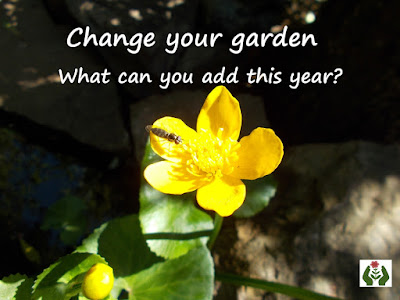You can keep your garden fresh and interesting by making a few changes every so often. Even on a small budget you can transform your garden over a period of time - one change at a time. So what could you add to your garden over the next 12 months? Here are a few things I've added to mine over the last 12...
Spring always feels like a time of renewal, as a variety of plants and wildlife reappear in the garden after an extended absence during the autumn and winter. Many plants are coming back into growth, and are flowering for the first time in a year, returning like old friends that have been away. The bees have returned.
Gardens are constantly, if gradually, changing, sometimes with a bit of help from us gardeners, and sometimes of their own volition. A garden would be too dull if it stayed the same forever, so it's good to appreciate the differences over time.
Here are six things from my garden that weren't there a year ago.
Change your garden - what can you add this year?
Alpine planter
I do love alpines. Particularly the ones that form little dense mats of foliage. They're very tactile, and look like plants in miniature - which they are really, having adapted themselves to extremes of climate by staying close to the ground.
I had an empty terracotta dish lying around unused, so picked up three little cushion forming alpines at the RHS Cardiff Show.
 |
| Alpine bowl planter |
Arctic Poppy - Papaver croceum
I sowed some seeds of this last year - I think they were free with a magazine. Only one successfully cane through the delicate seedling stage, but having done so, it survived, in a pot outside the back door, everything that winter (and spring!) threw at it, including being covered in six inches of snow in March.
 |
| Papaver croceum - Arctic poppy |
Honesty (Lunaria annua)
I sowed these last year too, with the intention of having the opaque silvery coin like seed pods to use indoors over winter. They are biennials so have started flowering this spring and so we should have seed pods later this year.
The flowers are more attractive than I was expecting, so I've planted several plants out into the garden, as well as keeping some under closer observation in pots.
 |
| Lunaria annua -Honesty |
 GREEN FINGERS TIP: When growing biennials like Honesty, Foxgloves or Verbena bonariensis, remember more every year, even if the previous year's batch are yet to flower. You need a batch growing this year to flower next year. If you don't it could be two years before you have more flowers from them.
GREEN FINGERS TIP: When growing biennials like Honesty, Foxgloves or Verbena bonariensis, remember more every year, even if the previous year's batch are yet to flower. You need a batch growing this year to flower next year. If you don't it could be two years before you have more flowers from them.
Daffodil "Minnow"
I can't remember where I saw these dwarf daffodils but last year I planted some and they have been a delightful addition to the display of bulbs this spring. They produce 4 or 5 flowers on each slender stem, miniature blooms that are very elegant. My only disappointment is that they are less strongly scented than I remember them being when I smelled them elsewhere.
Pond - Marsh Marigold
Perhaps the most significant addition to my garden in the last year could be just a few weeks ago when I created this little wildlife pond between the rock garden and the woodland area.
The aim is to attract wildlife, particularly slug hungry frogs or toads. I'll be posting details of how I made it in a week or two, but it only cost £20, including the plants. One of the plants is the Marsh Marigold, Caltha palustris, which as you can see is already flowering brightly, and as evidence by the title picture, also attracting pollinating insects too.
 |
| Wildlife pond with Marsh Marigold |
Related: Design for a wildlife garden
Pond - Tadpoles
As well as pollinating insects on the marsh marigold, we've had snails climbing up the iris stems, water boatmen on the surface, and as you see below, more than one tadpole. I introduced some frogspawn from another nearby pond, but wasn't sure any of it had survived the transfer. But once the sun came out this week, at least half a dozen tadpoles could be seen feeding near the surface.
 |
| Tadpoles in the pond |
So what do you plan to add to your garden this year?

